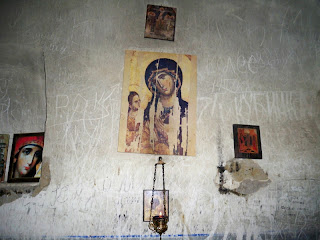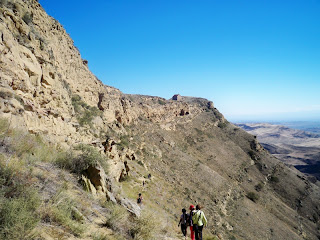გამარჯობა! როგორ ხარ?
Hope you remembered some Georgian from my last
post! If you didn’t, I’m saying “Hello, How are you?” So I went on
a cool excursion this weekend that I obviously want to tell you all
about. There’s a Facebook group basically dedicated to English speakers
in Georgia and some woman posted about an excursion to David Gareja and about 20 fellow TLG English teachers
signed up including myself and several people from my orientation group.
We met up on Friday in Tbilisi and basically just hung out eating some really
good cheese pizza and enjoying M&M McFlurry’s from McDonalds (Georgia has 3
McDonalds and I've successfully been to all of them now).
We got up bright and early on Saturday and
headed out to meet everyone for the journey which was supposed to set out at
7:30am but since this is Georgia we finally left around the Georgia Maybe Time (GMT) of
8:45am. The actual David Gareja complex of monasteries isn't that
far from Tbilisi (maybe about an hour at most since the roads are really
bad).
Our first stop was the Ioane Natlismtsemeli
Monastery which was about four kilometers (about 2.5 miles) from the main David
Gareja caves. The monk who was our guide provided some information (in
Georgian) and the girl who organized the trip attempted to translate most of
what he was saying; some of the information was lost in translation a little,
but I’ll attempt to remember what stood out the most. It’s a smallish
monastery in the side of a mountain dating back to the 6th century.
We went inside the church which was comprised of three main rooms and was
definitely old; most of the relics and frescoes on the walls were all
originals. Even though the place is literally hundreds of years old
and the original paint is still remaining we were allowed to take pictures:
.jpg) |
| Ioane Natlismtsemeli Monastery which was built into the side of this mountain/hill. |
.jpg) |
| 6th century church area |
.jpg) |
| The blue paint is the original coloring. The way to make the paint apparently just "came" to the monks in a message from God and it was the first time in which this color was ever used in a Georgian church. You can apparently still buy some of this paint but it costs like $15,000 and you have to wait many years to get it. Or something like that. |
.jpg) |
| A bigger look at the blue frescoes |
.jpg) |
| There was graffiti all over the place that was carved by those who don't believe in the Georgian Orthodox church. |
.jpg) |
| Bigger view of the church area. |
.jpg) |
| Some of the little caves at the first monastery. |
.jpg) |
| A view from the ground. |
This first stop on the excursion was pretty cool but I think
all of us were more eager to get to the actual David Gareja monastery. It
was built starting in the 6th century by St. David Garejeli who was a
monk that had just arrived in Georgia. Since that time, and particularly
in the 11-13th centuries, the monastery grew in prosperity yet was subject to
the many different takeovers the country of Georgia has experienced at the
hands of foreigners in its history. When Russia took over Georgia in 1921
the monastery was closed. In the 1980s the Soviet Union used the area to
train soldiers for their war in Afghanistan and obviously Georgians protested
and eventually military exercises in the area stopped. After the Soviet
Union collapsed in the 1990s, the area was eventually reopened and is now a
religious tourist site.
There was an actual part that is still a functioning
monastery with a few rooms/caves that are a little more modernized (we saw a
solar panel on top of one of the buildings). We basically just
toured the main area that contained a courtyard and the church of the
monastery. As is typical in Orthodox churches, the women of the
group had to cover their heads and wear scarfs wrapped around our waists if we weren't already wearing skirts. After spending a short time here, we all
went out of the monastery area to begin the climb up this huge hill (more like
a small mountain actually) that would lead us to the famous 6th century
caves of David Gareja. Here are some pictures of the monastery compound:
.jpg) |
| Towers at the David Gareja monastery. |
.jpg) |
| The monastery part of David Gareja that is still functioning as a place for Orthodox monks. This part is also built into the side of the mountain. |
The climb up the mountain was a perfect example of
differences between visiting national monuments in the United States and
visiting national monuments in Georgia. Back home the walk to the
caves would've been a full set of stairs or a paved path right up to
the caves (and maybe an elevator or something to accommodate physically
impaired guests). However, in Georgia, young and old alike scale the
dirt path leading up the mountain that has been outlined by countless
visitors before us (I did indeed see several old women attempting to
successfully come down from the mountain, I’m not sure how far they went up,
but I was scared they were going to break a hip the entire time). There
are no guard rails or guides along the way to keep everything in order or to
assist in case one should become injured. It’s just another part of
Georgia that makes it unique and makes the experience of climbing a mountain to
find some ancient caves all the more exhilarating.
It actually wasn't that bad of a climb overall,
and I think I’ve actually come to really enjoy these hiking adventures I’ve
done in Georgia, it’s certainly helping to make up for the lack of exercise I’m
getting in the village on a daily basis. If nothing else, it was worth it
to make it to the top since when we got reached the summit we found ourselves facing
Azerbaijan. Yeah, it was that close and obviously super
cool. David Gareja is basically on the border of Georgia and
Azerbaijan and has been a source of dispute between the two countries since the
early nineties. The sky above us was a picturesque blue and the
weather was perfect as we spent a good twenty minutes or more enjoying the view
and taking pictures.
.jpg) |
| This is me at the top of the hill/small mountain (one of the only ways to reach the David Gareja caves). Behind me is Azerbaijan, or what I imagine Mars or some planet in outer space looks like. |
The caves that would mark our final destination of the day were to
the left of this view, so we continued along the journey which again proved to
be a little frightening since the "path" was merely a foot-wide patch
of dirt that had been cleared for foot travel; there were stakes where guard
rails of some kind could be erected but, once again I've found myself literally
on the side of a mountain exploring. The caves really varied in size and
I'm not quite sure if some of them had a special purpose or not. Judging
by the remaining frescoes and sizes of some rooms, several had to have been
meeting places or bigger religious ceremony rooms used by the monks that have
previously inhabited this place centuries ago. Here are some pictures of
the hike:
.jpg) |
| The caves lined this wall of the mountain. This obviously wasn't the safest hike I've ever done but the view was amazing. Some of the caves were numbered 51, 52, 53 so I believe there are other parts which contain caves somewhere else that are still be uncovered and explored (there are supposedly hundreds of caves!). |
.jpg) |
| In some of the caves some of the original frescoes remain. Some people have placed money and religious icon pictures here. |
.jpg) |
| An example of some of the caves |
.jpg) |
| This area had really big frescoes that were still pretty much intact |
.jpg) |
| A view of the caves from the other side |
When we got to the other side, we found ourselves at the top of
the mountain again in a place where Georgian and Azerbaijani guards patrol
(read: stand around) together. I'm not quite sure of their purpose being
isolated up there, but the Azerbaijani guards were definitely more friendly
even though they knew little English other than "Hello,"
"California?" and "Michael Jordan." We didn't spend
much time up here before heading back down the mountain to end our day-long
exploration.
So, I’ve had another adventure to add to the Georgia life
chapter! I’m officially half-way done
with my experience here and there are still times that catch me off guard here
in Georgia that make me pause for a second and just think to myself, “I live in Georgia right now.” How
surreal is that? And it happened again
this weekend as I found myself on top of a mountain looking at Azerbaijan, a
country I never thought I would ever be this close too, and I was about to climb
all up in some 6th century caves which people typically only read
about in history books. This whole experience
has been such a roller coaster where some days I feel like crying and then
there are others in which I’m saddened by the fact that I’ll be leaving this crazy
place. But I honestly can say I’m in
love with my life right now, both here in Georgia and with everyone/everything I
have to look forward to back in the States come December. Here’s to the second half of the journey!
გაუმარჯოს! (cheers!)
Kelsey.
.jpg)
.jpg)
.jpg)
.jpg)
.jpg)
.jpg)
.jpg)
.jpg)
.jpg)
.jpg)
.jpg)
.jpg)
.jpg)
.jpg)
.jpg)
.jpg)
.jpg)
გამარჯობა :) We would like to share a good news for all travelers and backpackers going to Davit Gareji - on April 14th a direct marshrutka called Gareji Line starts to operate everyday from Tbilisi center :) We hope to see you soon in beautiful Georgia :)
ReplyDelete